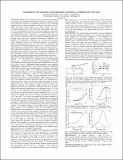Poroelasticity is the dominant energy dissipation mechanism in cartilage at the nano-scale
Author(s)
Tavakoli Nia, Hadi; Han, L.; Li, Y.; Ortiz, Christine; Grodzinsky, Alan J.
Download2011_ORS_v7.pdf (131.1Kb)
OPEN_ACCESS_POLICY
Open Access Policy
Creative Commons Attribution-Noncommercial-Share Alike
Terms of use
Metadata
Show full item recordAbstract
Recent studies of micro- and nano-scale mechanics of cartilage and chondrocyte pericellular matrix have begun to relate matrix molecular structure to its mechanical response. AFM-based indentation has revealed rate-dependent stiffness at the micro-scale. While multi-scale elastic behavior has been studied, and poro-viscoelastic properties have been extensively documented at the tissue-level, time-dependent behavior and energy dissipation mechanisms of cartilage matrix at the nano-scale are not well understood. Here, we used AFM-based dynamic compression in conjunction with poroelastic finite element modeling to study the frequency-dependent behavior of cartilage using nano-scale oscillatory displacement amplitudes. We introduce the characteristic frequency f[subscript peak] at which the maximum energy dissipation occurs as an important parameter to characterize matrix time-dependent behavior. Use of micron-sized AFM probe tips with nano-scale oscillatory displacements over a 3-decade frequency range enabled clear identification of this characteristic frequency f[subscript peak]. The length-scale dependence of poroelastic behavior combined with judicious choice of probe tip geometry revealed flow-dependent and flow-independent behavior during matrix displacement amplitudes on the order of macromolecular dimensions and intermolecular pore-sizes.
Date issued
2011-01Department
Massachusetts Institute of Technology. Department of Biological Engineering; Massachusetts Institute of Technology. Department of Materials Science and EngineeringJournal
Proceedings of the 2011 Orthopaedic Research Society Annual Meeting
Publisher
Orthopaedic Research Society
Citation
Tavakoli Nia, H., L. Han, Y. Li, C. Ortiz, and A. Grodzinsky. "Poroelasticity is the dominant energy dissipation mechanism in cartilage at the nano-scale." 2011 Orthopaedic Research Society Annual Meeting (January 2011).
Version: Author's final manuscript